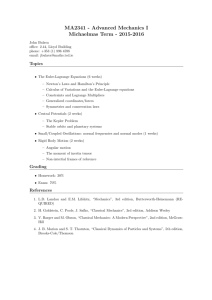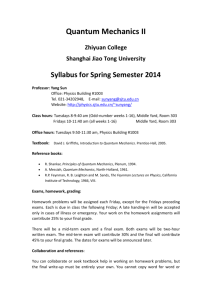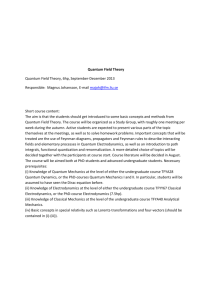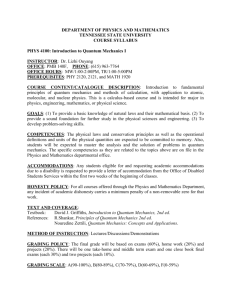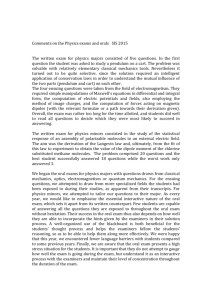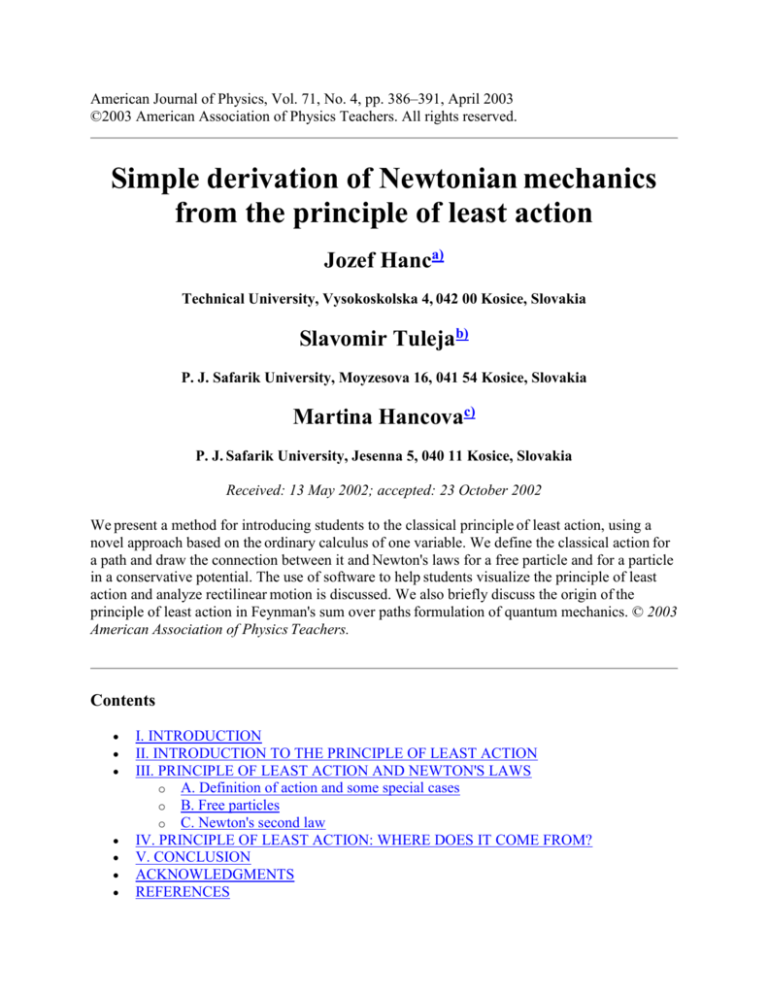
American Journal of Physics, Vol. 71, No. 4, pp. 386–391, April 2003
©2003 American Association of Physics Teachers. All rights reserved.
Simple derivation of Newtonian mechanics
from the principle of least action
Jozef Hanca)
Technical University, Vysokoskolska 4, 042 00 Kosice, Slovakia
Slavomir Tulejab)
P. J. Safarik University, Moyzesova 16, 041 54 Kosice, Slovakia
Martina Hancovac)
P. J. Safarik University, Jesenna 5, 040 11 Kosice, Slovakia
Received: 13 May 2002; accepted: 23 October 2002
We present a method for introducing students to the classical principle of least action, using a
novel approach based on the ordinary calculus of one variable. We define the classical action for
a path and draw the connection between it and Newton's laws for a free particle and for a particle
in a conservative potential. The use of software to help students visualize the principle of least
action and analyze rectilinear motion is discussed. We also briefly discuss the origin of the
principle of least action in Feynman's sum over paths formulation of quantum mechanics. © 2003
American Association of Physics Teachers.
Contents
I. INTRODUCTION
II. INTRODUCTION TO THE PRINCIPLE OF LEAST ACTION
III. PRINCIPLE OF LEAST ACTION AND NEWTON'S LAWS
o A. Definition of action and some special cases
o B. Free particles
o C. Newton's second law
IV. PRINCIPLE OF LEAST ACTION: WHERE DOES IT COME FROM?
V. CONCLUSION
ACKNOWLEDGMENTS
REFERENCES
FIGURES
FOOTNOTES
I. INTRODUCTION
Since Newton's time, classical mechanics has been elegantly reformulated as a single unifying
principle known as Hamilton's principle. Following Feynman1 and Landau,2 Hamilton's principle
is frequently called "the principle of least action." According to the least action formulation of
classical mechanics, a particle moves along the path for which the action (symbolized by S) is a
minimum. In some cases the true path does not yield a minimum for S but an inflection point or,
in general, a stationary value. Hence a more accurate name for this principle is the principle of
stationary action.3
A clear and interesting introduction to the principle of least action can be found in Ref. 1. How
are we to find the path of least action? This is a difficult problem belonging to the calculus of
variations. We will describe one way around this complicated mathematics which we believe
provides a deep understanding of the principle of least action for beginning students. The key
idea is based on a passage from Feynman's lectures,4 where he mentions that if the action S is
minimum along the true path, then it is also a minimum along every subsection of the path.
To explain the meaning of Feynman's statement, we will consider motion in only one space
dimension and plot the actual particle's motion in space and time, xA(t), a plot called a worldline.
The principle of least action says that the worldline xA(t) yields a minimal action. Now choose an
arbitrary subsection A of this worldline. Draw a nearby worldline xB(t) that differs from xA(t) only
on the section A, where xB(t) creates a new section B (see Fig. 1). As we will see in Sec. III A, the
total action for a worldline can be expressed as a sum of actions for each of its sections. The
value of the action is identical along common sections of both worldlines xA(t) and xB(t).
Therefore, the difference in the total action between xA(t) and xB(t) is due to different
contributions to the action from sections A and B. In order to not violate the condition of minimal
total action, the action for section B must be greater than action for the section A. But the location
of subsection A along the worldline was chosen arbitrarily. Therefore, we require that the
worldline with minimal action must also satisfy the principle of least action between any pair of
intermediary points. Consequently, the principle for the entire path can be stated in Feynman's
infinitesimal form:4 the action along an arbitrary infinitesimal section of the true worldline has a
minimal value. For an infinitesimal section it is unimportant how the potential varies from one
place to another place far away; only the local first-order change in the potential is important. So
the result can depend only on the derivative of the potential that is the force at a point.4
Figure 1.
If we proceed from this formulation (due to Feynman) of the principle for an infinitesimal section
of the path, we see that the principle of least action leads to Newton's second law, and only
ordinary calculus is needed to derive almost all of classical mechanics.5
In Sec. II we illustrate some of the features of our software which we use as a pedagogical tool
for introducing the least action formulation of classical mechanics. In Sec. III we use the
definition of the classical action to relate it to Newton's laws in two cases: the motion of a free
particle and a particle in a conservative potential field. Our variational method requires only
ordinary derivatives. Section IV briefly describes the meaning of action in quantum mechanics
and the origin of the classical principle of least action in Feynman's sum over paths formulation
of quantum mechanics.
Traditionally the principle of least action is taught in advanced classical mechanics courses.
However, the method described in this paper has allowed us to teach it as early as secondary
school. We include three pedagogical notes on teaching strategies derived from our use of the
principle of least action with classes at both the secondary school and university levels.6
II. INTRODUCTION TO THE PRINCIPLE OF LEAST ACTION
Feynman7 tells us that there are two natural ways to find the path that satisfies the principle of
least action. One is the trial-and-error method. We calculate the action for millions of paths and
find the one that has the smallest value of the action. Because this method is straightforward but
tedious, we turn it over to a computer.8 Using a computer also can help students to visualize and
develop an intuition for the process. Such a computer program is illustrated in Fig. 2. In
manipulating this program, the student naturally becomes accustomed to the central concepts of
worldline (a plot of the particle's position as a function of time) and event (a point on the
worldline). With almost no mathematical formalism the student can explore the motion of a
particle in various potentials by comparing the action along the true worldline with that along
alternative worldlines. For the worldline of least action the result is the same as that derived from
Newton's laws. On the display the student can see the numerical values of the action and the
following mechanical quantities on the particle's path: position, velocity, acceleration,
momentum, and energy.
Figure 2.
The second way to find the path that satisfies the principle of least action is mathematical. In
contrast to the trial-and-error method, mathematics allows us to include all possible paths and to
prove that the path minimizing action S is the one that obeys Newton's laws.
III. PRINCIPLE OF LEAST ACTION AND NEWTON'S LAWS
A. Definition of action and some special cases
Consider a particle of mass m that starts from some fixed initial position at time t1 and moves to a
fixed final position at a later time t2. The general expression for the action along the particle's
trajectory is
We use unconventional double letters KE and PE as symbols for the kinetic and potential
energies, respectively, because they are more mnemonic than the usual symbols T and V.
Equation (1a) can be written in the form
The average energies, KEav and PEav, are given by integrals similar to that in Eq. (1a) divided by
(t2–t1). Each of these averages is a function (or more exactly a functional) of the worldline taken
by the particle. Equation (1b) can be rewritten in many convenient ways, depending on the nature
of the analysis.
(1) If the worldline is straight, then the particle moves at a constant velocity and therefore with a
constant kinetic energy KE. In this case the action has the form
(2) If, in addition, the potential energy is a linear function along the straight worldline, then the
average value of PE equals the value of PE at the midpoint of the path. In this case
(3) Equation (1b) is valid for any increment of a particle's worldline:
(4) For a very small (or infinitesimal) increment of the worldline (therefore taken to be straight),
we can again use Eq. (2b):
(5) As we see from Eq. (1a), the action for an infinitesimal segment of worldline can be
expressed as
Equation (1b) leads to the same conclusion, because for an infinitesimal segment of a worldline,
the average energies can be substituted for the instantaneous energies. Equations (1a) and (1b)
embody the fact that the action is an additive quantity.
Pedagogical note 1: From the mathematical point of view, the definitions (1a) and (1b) are
equivalent, as can be shown by using the integral definition of the average value for a function.
But psychologically they are quite different, especially for students new to calculus. In our
experience students find the nonintegral definition more acceptable. Another advantage of
beginning with Eq. (1b) is that students already are aware of similar average quantities from
kinematics.
Expressions for the averages used in the action formula (1b) do not require the solution of
integrals in simple cases [see Eqs. (2a) and (2b)]. Because the integral is the same as the area
under a curve, elementary methods for the calculation of average values are sufficient, quick, and
easy. This connection between the integral and the area also provides a natural way to pass from
definition (1b) to the integral (1a). [End of the pedagogical note 1.]
B. Free particles
First we look at the predictions of the principle of least action for free particles in a zero (or
constant) potential. Newton's first law of motion tells us that the free object moves along a
straight worldline. So our first task is to solve the following problem.
Problem 1. From the principle of least action, show that a free particle that starts from some
position at time t1 (event 1) and arrives at a different position at time t2 (event 2), moves along a
straight worldline.
Solution: Consider only motion in one dimension. (It is not difficult to generalize to higher
dimensions.) Figure 3 shows some of the infinite number of worldlines that can connect events 1
and 2. Which worldline is the one actually followed by the particle?
Figure 3.
Consider any smoothly curved worldline that is different from a straight worldline between two
events. We can approximate this worldline by a series of straight-line segments that create a
broken but continuous worldline. The number of these segments can be arbitrary. Denote this
number by n. As will be seen, for the case of a broken worldline, it is easy to show by induction
that the smallest value of the action belongs to a straight worldline between the two events.
Because the smooth worldline can be considered as a limiting case of straight-line segment
approximation as n approaches infinity and the validity of the least action statement does not
change as n increases without limit, the action for the smooth worldline will always be greater
than the action along the straight worldline.
To take the first step of proof by induction, demonstrate the triangle inequality for action on any
broken worldline. Consider three events 1, 2, 3 connected by a broken worldline connecting
points 1, 2, 3 that are not collinear. Without loss of generality we can take events with equally
spaced times t1, t2, t3. (The analysis is the same for events not equally spaced in time, but is less
transparent because it requires more subscripts.) In particular we want to prove that S(13)<S(12)
+ S(23), where contributions to the action S(13), S(12), and S(23) correspond to the path
segments 13, 12, and 23 respectively. Consider the sum S(12) + S(23), which is equal to the total
action Stotal for the broken line 123 and recall that the action is additive. From Eq. (2a) and the
classical expression for the kinetic energy, we have
and
where xi denotes the positions of event i (i = 1,2,3), and
corresponding times.
t is the difference between the
We assume a nonzero spatially uniform potential energy PE. Then PEav equals PE and according
to Eq. (2a), corresponding actions have the form
and
If only x2 is variable, then the sum in both cases is a quadratic function of x2 with a positive
coefficient. (It is easy to verify this property by multiplying out the expression.) In this case the
parabola has a vertex that describes the minimum of the function.
If we take the derivative of Eq. (3a) with respect to x2, the result is
Note that we also obtain Eq. (4) for the derivative in a nonzero spatially uniform potential,
because the derivative of the additional term in the action in Eq. (3b) corresponding to constant
potential energy has zero value.
If we set the right-hand side in Eq. (4) equal to zero to find the minimum of the sum, we obtain9
or
Equation (5b) tells us that the slopes of the two segments have to be equal, which is true only for
a straight line. Therefore events 1, 2, and 3 lie on a straight worldline, which also implies the law
of conservation of momentum. So for both zero potential and uniform potential, every broken
worldline has a greater value of the action than the value corresponding to a straight worldline
connecting the same two end events. By induction (see Fig. 4) the same result holds for any
worldline composed of n straight-line segments, and in the limit as n
, it holds for any
continuous smooth worldline. The action has the smallest value for a straight worldline
connecting the events, that is, the motion corresponds to constant velocity.
Figure 4.
Pedagogical note 2: It is helpful to have students first consider the simplest possible case of the
motion of a free object in zero potential, namely, one in which the space coordinates of the initial
and final events are the same (x1 = x2). In this case the straight worldline with constant x
coordinate in the space–time diagram yields the value zero for the action S(12). Definition (1b)
for the action shows that the action is always non-negative, because the kinetic energy is a non-
negative quadratic function at every point on the worldline so its average value in the expression
for the action must be a non-negative number. Therefore, an arbitrary worldline connecting
events 1 and 2 will have an action greater than zero unless it is the straight worldline connecting
the two points. Consequently, the principle of least action tells us that the particle remains at rest
at the same point in space between the initial and final events. This demonstration avoids
calculus completely. [End of the pedagogical note 2.]
C. Newton's second law
When the potential energy varies with position, we can show that the path with minimal action
satisfies Newton's second law for forces derivable from a conservative potential. In the
following10 we apply Feynman's formulation of the principle of least action for the infinitesimal
path segments mentioned in Sec. I.
Consider an object moving in a potential energy field PE(x). Choose three events 1, 2, 3 that are
infinitesimally close together on its worldline, as shown in Fig. 5; these events approximate the
real-worldline segment by a once-broken line and represent a little section of a real worldline that
is initially unknown. Label A the segment between 1 and 2 and B the segment between 2 and 3.
Let x1, x2, x3 be the spatial coordinates of these events and t1, t2, t3 be the corresponding times.
Now use the principle of least action to find the true worldline representing real motion between
1 and 3.
Figure 5.
To start, fix all times and positions with the exception of x2. Then vary the position of x2 to
minimize the action for the once-broken path. To simplify the algebra, use equal time intervals
denoted by t:
The small loss in generality involved in equal time intervals can be removed easily (see
pedagogical note 3).
As in Sec. III A, especially from Eqs. (2d) and (6), we obtain contributions to the action for
segments A and B:
Now we have to find the value of x2 that minimizes the total action Stotal:
After taking the derivatives dS(A)/dx2 and dS(B)/dx2, we obtain
Because events 1, 2, 3 are close to one another, we can write for the derivatives
If we substitute Eqs. (12), (10), and (11) into Eq. (9), we arrive at the condition for the minimal
action,
After some rearrangements, we obtain
or
On the left-hand side of Eq. (14) is the well-known expression, the negative derivative of the
potential energy for a force F acting on a particle at point 2 in the potential field. The right-hand
side of Eq. (14b) divided by m is simply the three-point formula for the second derivative of x
with respect to t.11 In the limit of infinitesimal t, this term gives the instantaneous acceleration
a at the point 2. Hence, we obtain
We could continue and add other segments C,D,E,
so that we would cover the entire
worldline that describes the motion of the particle. For each of these segments the outcome yields
the same Eq. (15). So we have found the connection between the principle of least action and
Newton's second law. The worldline representing the path with minimal (stationary) action is the
one satisfying Newton's law.
Following Feynman,1 we remark on some other generalizations. Consider a situation in which a
particle in a potential field moves on an arbitrary path 1–2–3 in three-dimensional space. Each
translation in space can be analyzed as an independent translation in one of the three dimensions.
Therefore, we can think of carrying out independent translations in the x, y, and z directions, thus
arriving at the resulting three equations represent the component notation of one vector equation:
Fx = max, Fy = may, Fz = maz or the vector equation
Equation (16) is the general expression for Newton's second law. Using a similar procedure, we
can also generalize to the case of many particles.1
Pedagogical note 3: The preceding general variational method is a bit difficult for students. It is
sufficient if students are introduced to the result using a special case of the potential field, such as
the earth's gravitational field, for which the potential function is linear in one space dimension. In
that case the above procedure is more understandable and much more straightforward. Moreover,
the case of a linear potential energy function leads to only a quadratic function, which again
allows us to use a noncalculus derivation.9
The right-hand side of Eq. (14a) can be explained to students without knowledge of the threepoint formula for the second derivative. We identify the two terms in the numerator on the righthand side of Eq. (14a) as the average velocities on segments A and B. In other words, these
velocities are the values at the midpoints of line segments A and B. Because the estimated change
in velocity takes just the time t, the time between the midpoints of the segments, the rate in Eq.
(14a) represents the average acceleration.
Our software (see Fig. 2) calculates the acceleration at any point of the broken worldline
according to a more general formula that involves unequal times tA and tB for segments A
and B,
Equation (17) leads to the derivation of Newton's second law in a way closely similar to the case
of equal time lapses. The numerator of Eq. (17) is again the change in velocity, and the
denominator is the time between the midpoints of the segments. Students can use this fact to
generalize the acceleration formulas (14a)–(17) without needing to derive Newton's second law
for unequal time intervals. [End of the pedagogical note 3.]
IV. PRINCIPLE OF LEAST ACTION: WHERE DOES IT COME FROM?
The principle of least action says that a particle moves on the path for which the action S is a
stationary. After deriving Newton's laws from the principle of least action, then, according to
Feynman, some questions naturally arise: What is the origin of the principle of least action? How
does the particle find the right path (or worldline)? Does it "smell" the neighboring paths to find
out whether or not they have increased action?1
Newtonian mechanics cannot answer these questions. Indeed, the principle of least action has a
deep explanation in quantum mechanics. There are three apparently different mathematical
formulations of nonrelativistic quantum mechanics due to Schrödinger, Heisenberg, and
Feynman. The last one provides a simple justification of a minimum principle that is very
accessible to students.
We recapitulate briefly the basic ideas of Feynman's formulation of quantum mechanics.12
According to this formulation, the particle explores all possible paths between fixed initial and
final events. The action along these many paths plays a fundamental role. As Feynman says:13
"The complete quantum mechanics
works as follows: The probability that a particle starting
at point 1 at the time t1 will arrive at point 2 at time t2 is the square of probability amplitude. The
total amplitude can be written as the sum of the amplitudes for each possible path [worldline] for
each way of arrival. For every x(t)
we have to calculate an amplitude. Then we add them all
together. The amplitude is proportional to some constant times exp(iS/ ), where S is action for
that path."
It is the magnitude of S that leads to a seamless transition between classical and quantum
mechanics. If S is very large compared to Planck's constant (as is the typical situation for
systems described successfully by classical mechanics), we can say roughly that the amplitudes
for all paths have very different phases and cancel out in taking the sum, except for those that are
extremely close to the path with minimal action. So in the classical limit,
0, the quantum
result reduces to the principle of least action.
It is appropriate to remark that the demarcation between the domains of quantum and classical
theory does not necessarily coincide with the one separating macroscopic objects from
microscopic ones. (See the next example dealing with a wristwatch and a microprocessor.) The
previous criterion for the transition can be generalized to the quantum criterion:14 If an action (or
a parameter characterizing the physical situation or phenomenon that has the dimension of
action) has a numerical value comparable to Planck's constant, then the behavior of the system
must be described using quantum physics. If the action is much larger than , classical theory
offers an approximation sufficiently accurate for most purposes. So the magnitude of the action
characterizes the limits of validity of classical theories.
Here we give two examples for which the typical magnitude of the action can be successfully
estimated from a procedure based on dimensional analysis. A mechanical wristwatch15 has
moving parts with an approximate size d 10–4 m, mass m 10–4 kg, and typical time t 1 s.
So the characteristic action using dimensional analysis (the unit of S is J s) is S md2 t–1 10–
12
J s 1022 .
The microprocessor is the heart of every computer. The first Pentium processor (2×2 cm) was
made using 0.8 µm technology, which means that the thinnest wires were of size 0.8 µm (d
10–6 m). Because it is an electronic device, the operation of the microprocessor depends on
electrons (m 10–30 kg). The processor executes instructions during clock cycles. So the power
of processor is approximately given by the maximum clock speed, which was 60 MHz for the
first Pentium chip, corresponding to the angular frequency
400 MHz. The typical action is
represented by S
md2
4×10–34 J s 4 . Although these two systems are comparable in
size, the result is that the maker of a mechanical watch needs to know nothing about quantum
theory, whereas the creators of microprocessors, the basic constituents of modern information
technology, must use quantum theory to design their chips.
V. CONCLUSION
We have obtained Newton's second law from the principle of least action only for conservative
forces, for which there exists a potential function. But the Newtonian formulation of classical
mechanics extends readily from this conservative case to nonconservative (dissipative) cases like
friction. Are Newton's laws of motion more general than the principle of least action? The
answer is again in Feynman's lectures.16 At the microscopic level, there are no dissipative forces.
Friction appears only because we neglect microscopic complications resulting from a large
number of interacting particles, for which it would be practically impossible to carry out an exact
analysis. Although the Newtonian formulation helps effectively to eliminate complications such
as the case of friction, Newton's laws cannot be extrapolated to things that are very small or very
fast or very large. Indeed, it turns out that the fundamental laws can be set in the form of a
principle of least action. From a principle of least action we can derive Maxwell's equations,17
and can use this principle in relativity10 if we find the correct form for the action. The action is
very important in many fields of modern physics. We believe that students should be introduced
to it early and that the present approach18 is one possible way of doing so.
ACKNOWLEDGMENTS
This paper was written after reading Taylor and Wheeler's book10 and Taylor's materials8 on
quantum mechanics. We would like to thank Edwin F. Taylor for providing the book, materials,
and helpful comments on this paper. We are also grateful to Slavko Chalupka of the P. J. Safarik
University, who discussed with us many of the problems mentioned in the paper and also
encouraged us.
REFERENCES
Citation links [e.g., Phys. Rev. D 40, 2172 (1989)] go to online journal abstracts. Other links (see
Reference Information) are available with your current login. Navigation of links may be more
efficient using a second browser window.
1. R. P. Feynman, R. B. Leighton, and M. Sands, The Feynman Lectures on Physics
(Addison-Wesley, Reading, MA, 1964), Vol. 2, Chap. 19. first citation in article
2. L. D. Landau and E. M. Lifshitz, Mechanics (Butterworth-Heinemann, Oxford, 1976),
Sec. 1.2. first citation in article
3. W. R. Hamilton, "On a general method of expressing the paths of light, and of the planets
by the coefficients of a characteristic function," Dublin University Review and Quarterly
Magazine 1, 795–826 (1833), available at
4.
5.
6.
7.
8.
http://www.maths.tcd.ie/pub/HistMath/People/Hamilton/Papers.html , edited by David
R. Wilkins. first citation in article
Reference 1, p. 19-8. first citation in article
Our analysis will consider Hamilton's principle in the form that describes the mechanics
of conservative systems (or generalized potentials). On the other hand, there exists an
extension of Hamilton's principle that includes nonconservative and nonholomonic
systems. See H. Goldstein, Classical Mechanics (Addison-Wesley, New York, 1970),
Chaps. 2–4. first citation in article
The contents of this article were taught by the first author as a special topic in a semester
quantum mechanics course developed after Taylor's course (Ref. 8) for future teachers of
physics at the Faculty of Science, P. J. Safarik University, Kosice, Slovakia. It was also
tried for three months in a special physics seminar devoted to modern physics at a
secondary school, Gymnazium of J. A. Rayman, Presov, in Slovakia. first citation in
article
Reference 1, p. 19-3. first citation in article
The basic idea of using computers comes from E. F. Taylor;
see especially p. 192 in E. F. Taylor, S. Vokos, J. M. O'Meara, and N. S. Thornber,
"Teaching Feynman's sum over paths quantum theory," Comput. Phys. 12, 190–199
(1998);
and E. F. Taylor, Demystifying Quantum Mechanics, a workbook for quantum mechanics
available at http://www.eftaylor.com . Our software is based on Taylor's software
which accompanies his workbook. first citation in article
9. This minimum condition can be obtained without calculus if we use the expression x =
b/2a for the position of the vertex of a parabola described by y = ax2 + bx + c. first
citation in article
10. A very similar, easy, and successful variational method has been applied in general
relativity in E. F. Taylor and J. A. Wheeler, Exploring Black Holes: An Introduction to
General Relativity (Addison-Wesley Longman, New York, 2000). first citation in article
11. This term can be derived from a Taylor's series. See E. W. Schmid, G. Spit, and W.
Losch, Theoretical Physics on the Personal Computer (Springer-Verlag, Berlin, 1988),
Chap. 2, p. 14. first citation in article
12. See the following advanced texts: R. P. Feynman and A. R. Hibbs, Quantum Mechanics
and Path Integrals (McGraw-Hill, New York, 1965);
or L. S. Schulman, Techniques and Applications of Path Integration (Wiley, New York,
1996). first citation in article
13. Reference 1, p. 19-9. first citation in article
14. E. H. Wichman, Quantum Physics (McGraw Hill, New York, 1967), Sec. 1.20
or J. M. Lévy-Leblond and F. Balibar, QUANTICS: Rudiments of Quantum Physics
(North-Holland, New York, 1990), Sec. 1.3. first citation in article
15. The example dealing with a wristwatch was taken from Ref. 14. According to Ref. 14
(both books), dimensional analysis with a general quantum criterion allows us to
determine the quantum (or classical) nature of many phenomena (for example, a thrown
stone, swinging pendulum, radio antenna, oscillating electrical circuit, hydrogen atom,
salt crystal, superfluid helium, nucleus, diffracted photon, Coulomb and nuclear
scattering of particles). first citation in article
16. Reference 1, p. 19-7. first citation in article
17. L. D. Landau and E. M. Lifshitz, The Classical Theory of Fields (Pergamon, New York,
1975), Chap. 4, pp. 66–75. first citation in article
18. To obtain draft exercises, software and more detailed information, see
http://www.LeastAction.host.sk or the mirror site http://LeastAction.topcities.com .
first citation in article
CITING ARTICLES
This list contains links to other online articles that cite the article currently being viewed.
1. Hamilton's principle: Why is the integrated difference of the kinetic and potential energy
minimized?
Alberto G. Rojo, Am. J. Phys. 73, 831 (2005)
2. Getting the most action out of least action: A proposal
Thomas A. Moore, Am. J. Phys. 72, 522 (2004)
3. From conservation of energy to the principle of least action: A story line
Jozef Hanc et al., Am. J. Phys. 72, 514 (2004)
4. Deriving Lagrange's equations using elementary calculus
Jozef Hanc et al., Am. J. Phys. 72, 510 (2004)
5. Symmetries and conservation laws: Consequences of Noether's theorem
Jozef Hanc et al., Am. J. Phys. 72, 428 (2004)
FIGURES
Full figure (4 kB)
Fig. 1. Two nearby worldlines (height vs elapsed time) xA(t) and xB(t), where xA(t) represents the
actual particle's worldline and xB(t) is an alternative worldline, which differs from xA(t) only on
section A, which is modified as a new section B. First citation in article
Full figure (18 kB)
Fig. 2. A worldline of a particle in the Earth's gravitational field. At this point students know only
that for every path represented by a worldline x(t), there exists one number, which is called the
action S and that the real path obeys the principle of least action. The software shows students
how the principle of least action leads to a unique worldline. Students can choose any worldline
for the particle by selecting points (events) that the computer connects with a line. Students drag
these points while the computer immediately displays the value of the action S and the table of
acceleration or other quantities (position, velocity, momentum, energy) describing the motion.
Students soon discover that the path with minimal action has the same acceleration (–9.8 m/s2) at
each point, which describes free fall due to gravity. The path that satisfies the principle of least
action also conserves total energy. First citation in article
Full figure (4 kB)
Fig. 3. Some of the possible motions of a free particle. The true path is represented by a straight
worldline, as we know from Newton's first law. First citation in article
Full figure (3 kB)
Fig. 4. Consider a broken worldline 1234. According to the triangle inequality, the action for the
broken worldline 123 is greater than the action for line segment 13. It follows that the broken
worldline 134 has a lower action than 1234. For 134 we can use the triangle inequality again, so
that the action for segment 14 is less than the one for 134, and thereby less than the action for
1234. First citation in article
Full figure (5 kB)
Fig. 5. Section of worldline (represented by two connected straight-line segments) of a particle
moving in the potential field described by PE(x). The events 1, 2, and 3 are three successive
events on the particle's worldline. All space and time coordinates are fixed, with the exception of
x2, which we change to satisfy the principle of least action. First citation in article
FOOTNOTES
a
Electronic mail: jozef.hanc@tuke.sk
b
c
Electronic mail: tuleja@stonline.sk
Electronic mail: hancova@science.upjs.sk
Up: Issue Table of Contents
Go to: Previous Article | Next Article
Other formats: HTML (smaller files) | PDF (248 kB)



